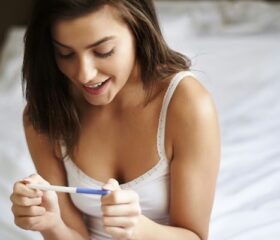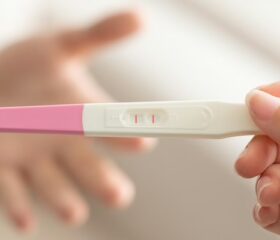Faint Positive Line on an Ovulation Test: Are You Ovulating or Pregnant?
You’ve taken an ovulation test only to find yourself squinting at it, trying to figure out what that faint line you’re seeing is all about.

- What are ovulation tests?
- Does a faint line on your ovulation test mean you’re pregnant?
- What does a faint line on your ovulation test mean?
- What if the lines on your ovulation tests are always faint?
- How to get clearer results with your ovulation test
- Does a positive ovulation test always mean you’re ovulating?
- Final thoughts
While ovulation tests are accurate most of the time, they’re by no means perfect, and seeing a faint line can leave you scratching your head. Are you actually ovulating? Is there something wrong with your hormones? Are you pregnant?
Read on to learn how ovulation tests work, whether a faint positive line on your test could mean you’re pregnant, and how to get clearer results.
What are ovulation tests?
Ovulation tests, also known as ovulation predictor kits (OPKs), help you identify your fertile window each month—before and immediately after you ovulate (when your ovaries release an egg into your uterus to be fertilized by sperm).
OPKs work by detecting the level of luteinizing hormone (LH) in your urine. Your pituitary gland produces this hormone, and while it’s present in small amounts throughout your menstrual cycle, your LH levels surge between 16 and 48 hours before you ovulate. 1 When it spikes, that means you’re entering your fertile window.
How to take and read an ovulation test
Depending on your test’s instructions, you’ll either have to collect a sample of your urine or stick the test strip into your urine stream. You’ll then need to wait a few minutes after testing to read the results.
Like pregnancy tests, ovulation tests usually have two lines: a control line (to prove the test is working) and a testing line.
If you get a positive result, the test line will be at least as dark as the control line. If it is, you’re either ovulating or will ovulate within the next 24 or 36 hours. 2
If the test line is much lighter than the control line or not visible at all, that’s a negative result, which means you aren’t close to your fertile window yet or your ovulation is over.
Positive vs. negative vs. invalid ovulation test results
Refer to the image below for an idea of what these results look like in practice. Bear in mind that different brands of OPKs might display their results in slightly different ways.

Does a faint line on your ovulation test mean you’re pregnant?
You may have heard that if you see a faint line on your ovulation test, it suggests that, although you’re not ovulating, you may be pregnant.
This isn’t usually the case. Most of the time, a faint result on your test means you’re relatively early in your menstrual cycle. You’re getting close to your fertile window, but haven’t entered it yet.
Alternatively, it’s possible that your fertile window just passed and you’re now leaving it. Either way, your result probably doesn’t indicate you conceived.
How ovulation tests can sometimes detect pregnancy
With that said, it’s possible for your ovulation test to be positive if you’re pregnant, but OPKs can only detect pregnancy by accident. This happens because LH and human chorionic gonadotropin (hCG), the hormone that pregnancy tests look for, have very similar molecular structures.
This means that it’s possible for an ovulation test to mistake the hCG in your urine for LH. 3 4 If you’re pregnant and take an ovulation test around the time your next period would have been due (which is the earliest you can get accurate results from an at-home pregnancy test), you may see a dark (or faint) testing line on it.
However, this doesn’t always happen, so using an ovulation test to check for pregnancy isn’t a good idea.
If you suspect you might be pregnant (e.g., you’ve missed your period or are experiencing early pregnancy symptoms), always check with an actual pregnancy test.
What does a faint line on your ovulation test mean?
Again, if your ovulation test shows a faint line, rather than telling you that you’re pregnant, it’s more likely that:
- Ovulation is still several days away, or
- It happened already, and your LH is decreasing back to baseline 5
When you’re closer to ovulation, your test line will grow noticeably darker than the control line on your OPK.

Be aware that, although we’ve described how this usually works, none of it is absolutely guaranteed. Bodies can be unpredictable, and the way that LH rises and falls can vary from woman to woman and even month to month.
What to do after seeing a faint line on your ovulation test
If you get a faint positive line on your ovulation test, the best thing to do is test again in a few days. You’ll probably get a clearer result as your LH levels continue rising (if you haven’t ovulated yet) or falling (if you have).
Ideally, you’ll keep testing—ideally at the same time each day—and compare your results over the course of several days to figure out what a positive result on your ovulation test looks like for you.
What does it mean if you don’t see a test line at all?
If the test line is completely absent, your levels of LH are too low for your test to detect. This can happen if you miscalculated your ovulation day and are far off from the LH surge.
This is distinct from the absence of a control line, which means that your test is invalid or malfunctioning.
If you don’t see the control line (or you see two faint lines on your ovulation test, meaning the control line is unclear), you’ll need to throw it out and try with a new one.
Drinking too much water can also cause an unclear result
If you drink large amounts of fluids before testing, your urine may be too diluted to get a clear result. To get more accurate results, you should limit your fluid intake for a few hours before testing.
What if the lines on your ovulation tests are always faint?
Seeing one faint positive on an ovulation test might not be that much of a hiccup, but what if you consistently see faint lines on your ovulation tests over several days, weeks, or even months? Does that suggest anything about your fertility or overall health?
The answers to those questions depend on a lot of factors. Your best course is to speak with your doctor, as there could be a medical issue that’s preventing you from ovulating normally.
In more detail, here are the most common reasons you could be seeing consistently faint lines on your ovulation tests:
Your body’s natural LH levels are unusual
Not everyone experiences the same type of LH surge each month. One study found that around 43% of participants had rapid LH surges lasting less than 24 hours. If you only test once a day, it’s possible to miss this short, sharp peak, only catching the rise or fall (which appear as faint lines). 6
Also, if your baseline LH tends to be lower—something that can also happen naturally—and the test isn’t sensitive enough, you might also get consistently faint results on your OPKs, month after month. 7
You have a medical issue
More seriously, certain medical issues can also depress your LH levels and give you a faint line on your ovulation test.
For instance, if you’re dealing with a lot of stress, this can cause imbalances in LH and other hormones. If you’re obese, that can cause your body to produce too many androgens (sex hormones such as testosterone), which can prevent your ovaries from producing mature follicles. 8
Don’t try to self-diagnose if your LH levels seem consistently low. Again, the right move is to talk to your doctor.
How to get clearer results with your ovulation test
Although all of the complicating factors listed above are possible, it’s unlikely that your ovulation test is faulty or being thrown off by a medical condition.
It’s far more likely that you used the test incorrectly.
Fortunately, you can take a couple of steps to ensure your ovulation test is accurate:
Read the instructions carefully
Different brands have slightly different instructions for how to use them and how to read the results. Always follow your test kit’s instructions.
You should also see if your test specifies that you should test at a certain time of the day (although most ovulation kits are generally fine to use throughout the day, so long as you test around the same time from one day to the next).
As mentioned, you should also avoid drinking too much water before taking an ovulation test so your urine doesn’t become too diluted.
Test at the right time of the month
Knowing what time of the month to test can also give you clearer results. If you have a regular 28-day cycle, you’ll probably ovulate around day 14 (counting from the date of your last period). You should start taking an ovulation test around 10 to 11 days into your cycle. 9
If your cycles are irregular, you might find that ovulation tests are trickier to use. You could try using the date of your shortest cycle to figure out when to begin testing. 10 It’s also a good idea to chat with your doctor if you’re trying to track ovulation with irregular periods or get pregnant with them.
Test frequently
Ovulation tests work much better when you use them to track trends in your cycle rather than to pinpoint when you’re ovulating with just one data point. Try to test over several days, and pay attention to what happens to the testing line (i.e., whether it gets darker or fainter as your cycle progresses).
Use ovulation tests alongside other tracking methods
While OPKs are accurate and easy to use, they’re not the only method of detecting ovulation. You might find it useful to use them alongside other tracking methods, such as monitoring for ovulation symptoms.
While not all women have noticeable symptoms, you may experience: 11
- Breast tenderness
- Increased libido
- Abdominal pain (mittelschmerz) in one side
- Bloating and gas
- Changes to your cervical fluid (many women say that the consistency of their ovulation discharge often strongly resembles raw egg whites)
You can try using these methods in concert with a fertility tracker app, which records your symptoms and menstrual cycle length to predict when you’re ovulating.
More simply, you can also use an ovulation calculator, which can help you identify your most fertile days based on the date of your last period.
Try using a digital ovulation test
Last but not least, if you’re having trouble getting clear results with OPKs, you can try a digital ovulation test.
These take away some of the ambiguity from your ovulation test results by displaying a clear sign like a smiley face if you get a positive result (rather than a line that you have to judge the color of).
However, these tests usually come with a higher price tag than “normal” (analog) tests.
Does a positive ovulation test always mean you’re ovulating?
Keep in mind that regardless of whether you see a faint or dark line, ovulation tests don’t actually confirm ovulation. They simply detect the levels of LH in your urine.
What else could give you a positive ovulation test result?
While LH does surge in the lead-up to ovulation, hormone spikes like this can have other causes, so it doesn’t always mean your ovary is about to release a mature egg.
For instance, women who suffer from polycystic ovarian syndrome (PCOS) often have higher baseline LH levels, making it tricky to determine when they’re due to ovulate. 12
You may also get a false positive due to:
- Perimenopause: Ovarian function declines during perimenopause (the several years before menopause). During this period, your estrogen and progesterone levels decrease, and your LH levels may increase. This can lead to positive ovulation tests even if ovulation is infrequent or absent entirely (referred to as having an anovulatory cycle). 13 14
- Certain fertility medications: Some medications used in fertility treatments can cause LH levels to rise, which may be picked up by an OPK even if ovulation isn’t actually imminent. 13
- Luteinized unruptured follicle syndrome (LUFS): In this condition, a follicle develops and produces hormones (including triggering an LH surge), but it fails to rupture and release the egg. 15
If you’re trying to track ovulation with PCOS or any of these conditions, or you suspect you might not be ovulating despite positive ovulation test results, make sure you speak to your doctor.
Final thoughts
Although seeing a faint line on an ovulation test can sometimes tell you that you’re pregnant, it’s unlikely. Don’t rely on ovulation tests to figure out whether you’re expecting—that’s what pregnancy tests are for.
Usually, a faint line indicates that you have some LH in your urine, but aren’t actually ovulating yet. An actual positive ovulation test will feature a test line that’s as dark as (or darker than) the control line, signaling that you’ll ovulate within the next 16–48 hours.
Of course, every woman’s body is different. To really get a handle on your cycle, your best bet is to chat with your doctor or a fertility specialist.
Article Sources
- ColumbiaDoctors. "Find Your Ovulation Day" Retrieved September 19, 2025.
- MedlinePlus. "Ovulation home test" Retrieved September 19, 2025.
- WebMD. "How to Use an Ovulation Test" Retrieved September 19, 2025.
- U.S. Food & Drug Administration. "Guidance for Over-the-Counter (OTC) Human Chorionic Gonadotropin (hCG) 510(k)s - Guidance for Industry and FDA Reviewers/Staff" Retrieved September 19, 2025.
- WebMD. "How to Use an Ovulation Test" Retrieved September 19, 2025.
- Department of Obstetrics, Gynecology and Women’s Health, and Department of Preventive Medicine and Community Health UMDNJ New Jersey Medical School. "Characteristics of the urinary luteinizing hormone surge in young ovulatory women" Retrieved September 19, 2025.
- MedlinePlus. "Luteinizing Hormone (LH) Levels Test" Retrieved September 19, 2025.
- Cleveland Clinic. "Anovulation" Retrieved September 19, 2025.
- Johns Hopkins Medicine. "Calculating Your Monthly Fertility Window" Retrieved September 19, 2025.
- American Pregnancy Association. "How to Track Ovulation With Irregular Periods" Retrieved September 19, 2025.
- American Pregnancy Association. "Ovulation Symptoms – Am I Ovulating?" Retrieved September 19, 2025.
- Cleveland Clinic. "Luteinizing Hormone" Retrieved September 19, 2025.
- American Pregnancy Association. "How to Use Ovulation Kits & Fertility Monitors" Retrieved September 19, 2025.
- Endocrinology Catalog. "Luteinizing Hormone (LH), Serum" Retrieved September 19, 2025.
- Natural Womanhood. "Luteinized Unruptured Follicle (LUF): An explanation for ‘unexplained infertility’" Retrieved September 19, 2025.







